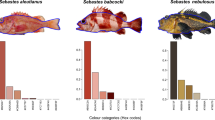Abstract
The values reported in the literature for the total gastrointestinal tract (GIT) content mass of elephants are lower than expected from interspecific mammalian regression. This finding agrees with theoretical considerations that elephants should have less capacious GITs than other herbivorous mammals, resulting in short ingesta retention times. However, the data on elephants was so far derived from either diseased zoo specimens or free-ranging animals subjected to an unknown hunting stress. In this study, we weighed the wet contents of the GIT segments of a captive African elephant that was euthanased because of a positive serological tuberculosis test, but that was clinically healthy, did not show a reduced appetite, and ingested food up to the time of euthanasia. The animal weighed 3,140 kg and its total gut contents were 542 kg or 17% of body mass. This is in close accord with the published mammalian herbivore regression equation of Parra (Comparison of foregut and hindgut fermentation in herbivores. In: Montgomery GG (ed) The ecology of arboreal folivores. Smithsonian Institution Press, Washington DC, pp205–230, 1978) and contradicts the notion that elephants have comparatively less capacious gastrointestinal tracts. Data on the individual gut segments, however, do support earlier suspicions that elephants have a comparatively less capacious caecum and a disproportionally capacious colon.


Similar content being viewed by others
References
Benedict FG (1936) The physiology of the elephant. Carnegie Institution of Washington, Washington
Buss IO (1961) Some observations on food habits and behaviour of the African elephant. J Wildl Manage 25:131–148
Clauss M, Frey R, Kiefer B, Lechner-Doll M, Loehlein W, Polster C, Streich WJ, Rößner GE (2003) The maximum attainable body size of herbivorous mammals: morphophysiological constraints on foregut, and adaptations of hindgut fermenters. Oecologia 136:14–27
Clemens ET, Maloiy GMO (1982) Digestive physiology of three East African herbivores, the elephant, rhinoceros and hippopotamus. J Zool Lond 198:141–156
Demment MW, Van Soest PJ (1985) A nutritional explanation for body-size patterns of ruminant and nonruminant herbivores. Am Nat 125:641–672
Gilchrist W (1851) A practical treatise on the treatment of the diseases of the elephant, camel, and horned cattle, with instructions for preserving their efficiency. Calcutta (cited by Benedict 1936)
Hungate RE, Phillips GD, McGregor A, Hungate DP (1959) Microbial fermentation in certain mammals. Science 130:1192–1194
Laws RM, Parker ISC (1968) Recent studies on elephant populations in East Africa. Symp Zool Soc Lond 21:319–359
Laws RM, Parker ISC, Johnstone RCB (1975) Elephants and their habitats. The ecology of elephants in North Bunyoro, Uganda. Clarendon Press, Oxford
Loehlein W, Kienzle E, Wiesner H, Clauss M (2003) Investigations on the use of chromium oxide as an inert external marker in captive Asian elephants (Elephas maximus): passage and recovery rates. In: Fidgett A, Clauss M, Ganslosser U, Hatt JM, Nijboer J (eds) Zoo animal nutrition, vol II. Filander, Fürth, Germany, pp 223–232
Noback CV (1932) 36th Annual Report, New York Zoological Society, p 58 (cited by Benedict 1936)
Parra R (1978) Comparison of foregut and hindgut fermentation in herbivores. In: Montgomery GG (ed) The ecology of arboreal folivores. Smithsonian Institution Press, Washington DC, pp 205–230
Robertson-Bullock W (1962) The weight of the African elephant (Loxdonta africana). Zool Soc Lond 138:133–135
Shoshani J et al (1982) On the dissection of a female Asian elephant (Elephas maximus) and data from other elephants. Elephant 2:3–93
Van Hoven W, Prins RA, Lankhorst A (1981) Fermentative digestion in the African elephant. S Afr J Wildl Res 11:78–86
Acknowledgements
We thank Camille Forel (Safari de Peaugres), Patrick Paubel (Etablissement Point équarissage), Valeria Café-Marçel, Helena Nimmervoll, Stefan Hoby, and Jérôme Foellmi for their support in planning and performing the dissection of the elephant. This is contribution no. 18 of the DFG research unit “Biology of the Sauropod Dinosaurs”.
Author information
Authors and Affiliations
Corresponding author
Rights and permissions
About this article
Cite this article
Clauss, M., Robert, N., Walzer, C. et al. Testing predictions on body mass and gut contents: dissection of an African elephant Loxodonta africana Blumenbach 1797. Eur J Wildl Res 51, 291–294 (2005). https://doi.org/10.1007/s10344-005-0113-0
Received:
Accepted:
Published:
Issue Date:
DOI: https://doi.org/10.1007/s10344-005-0113-0




